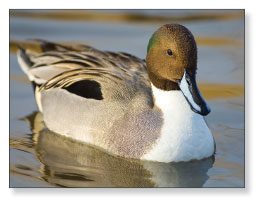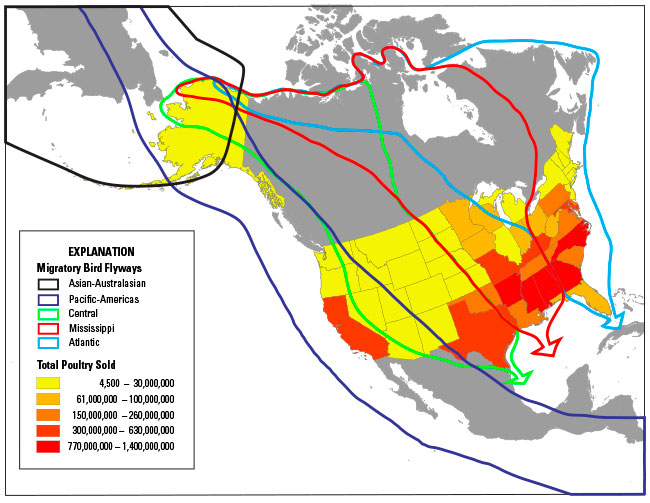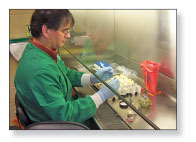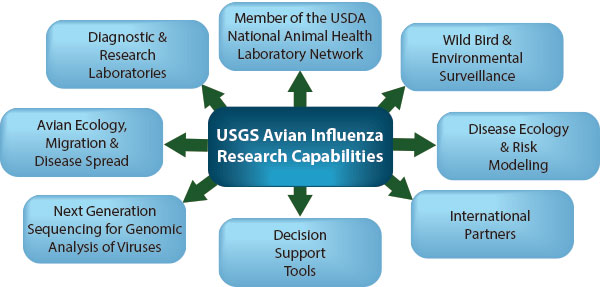Fact Sheet 2015–3059
Background
Migratory waterfowl, such as this Northern Pintail (Anas acuta), are common carriers of avian influenza throughout North America and Asia. USGS research demonstrated that these birds are involved in the dispersal of avian influenza between Asia and North America. Photograph by B. Guzetti, U.S. Geological Survey. Avian influenza viruses are naturally occurring in wild birds such as ducks, geese, swans, and gulls. These viruses generally do not cause illness in wild birds, however, when spread to poultry they can be highly pathogenic and cause illness and death in backyard and commercial farms. Outbreaks may cause devastating agricultural economic losses and some viral strains have the potential to infect people directly. Furthermore, the combination of avian influenza viruses with mammalian viruses can result in strains with the ability to transmit from person to person, possibly leading to viruses with pandemic potential. All known pandemic influenza viruses have had some genetic material of avian origin. Since 1996, a strain of highly pathogenic avian influenza (HPAI) virus, H5N1, has caused infection in wild birds, losses to poultry farms in Eurasia and North Africa, and led to the deaths of several hundred people. Spread of the H5N1 virus and other influenza strains from China was likely facilitated by migratory birds. In December 2014, HPAI was detected in poultry in Canada and migratory birds in the United States. Since then, HPAI viruses have spread to large parts of the United States and will likely continue to spread through migratory bird flyways and other mechanisms throughout North America. In the United States, HPAI viruses have severely affected the poultry industry with millions of domestic birds dead or culled. These strains of HPAI are not known to cause disease in humans; however, the Centers for Disease Control and Prevention (CDC) advise caution when in close contact with infected birds. Experts agree that HPAI strains currently circulating in wild birds of North America will likely persist for the next few years. This unprecedented situation presents risks to the poultry industry, natural resource management, and potentially human health. Scientific knowledge and decision support tools are urgently needed to understand factors affecting the persistence of HPAI in wild birds, to forecast future spread of HPAI by wild birds, and to detect novel strains of HPAI that may emerge. 
Migratory bird flyways in North America in relation to total number of poultry sold in 2012 by State. The map depicts three important concepts: (1) Asian and North American wild bird migratory flyways overlap in Alaska; (2) this overlap creates routes of introduction and virus spread into North America; and (3) shows the potential for impacts to the U.S. poultry industry depending on the flyway where highly pathogenic avian influenza is detected. Poultry data from the 2012 Census of Agriculture (agcensus.USDA.gov). 
The USGS tests thousands of avian influenza samples annually from across the United States and adjacent countries to determine virus distribution, strain type, molecular evolution, and pathogenicity. Why the USGS Is InvolvedAs the science agency of the U.S. Department of the Interior (DOI), the U.S. Geological Survey (USGS) has been conducting research on avian influenza since 2006. USGS is part of the State and Federal interagency team for the detection and response to HPAI viruses in North America. The U.S. Department of Agriculture and DOI actively coordinate with other State and Federal wildlife, agricultural and human health agencies to understand avian influenza distribution and dynamics to aid natural resource managers, agricultural officials and the poultry industry with this disease. Key USGS Avian Influenza Research Findings since 2006
The USGS Role and Response to Highly Pathogenic Avian Influenza in North AmericaThe USGS conducts research on avian influenza at multiple science centers across the nation and has amassed substantial national and international expertise investigating this disease. Scientists are defining the role of migratory birds in viral spread, characterizing genetics of viruses in wild birds, determining water conditions affecting survival of the virus in wetlands, and describing stages of infection in migratory birds. Additionally, USGS has capabilities in avian influenza diagnostics, surveillance and mathematical modeling to map potential risk factors for disease spread between wild and domestic bird species. In December 2014, the USGS was instrumental in first detecting HPAI viruses in wild birds of North America through its wildlife health and diagnostic network. The USGS has contributed substantial resources to enhance surveillance for HPAI across North America and to provide scientific information about the type, distribution, and wildlife species that harbor HPAI through timely public alerts (Wildlife Health Bulletins), a new online Wildlife Health Information Sharing Partnership – Event Reporting System (WHISPers), and scientific publications. In collaboration with partners, USGS developed a national science strategy for HPAI. This science plan will augment on-going research to allow forecasts of future disease spread by wild birds, detection of novel strains, characterization of factors that control survival of HPAI in the environment, and risk assessments to poultry, natural resources, and human health. 
The USGS has considerable scientific capabilities nationwide to investigate avian influenza. USGS Web Links and Selected PublicationsUSGS National Wildlife Health Center USGS Alaska Science Center USGS Patuxent Wildlife Research Center https://www.pwrc.usgs.gov/health USGS Western Ecological Science Center http://www.werc.usgs.gov WHISPers https://www.nwhc.usgs.gov/whispers/ USGS Avian Influenza Web Visualization Tool http://www.pwrc.usgs.gov/ai/ |
First posted September 9, 2015 For additional information, contact: Part or all of this report is presented in Portable Document Format (PDF). For best results viewing and printing PDF documents, it is recommended that you download the documents to your computer and open them with Adobe Reader. PDF documents opened from your browser may not display or print as intended. Download the latest version of Adobe Reader, free of charge. More information about viewing, downloading, and printing report files can be found here. |
Harris, M.C., Miles, A.K., Pearce, J.M., Prosser, D.J., Sleeman, J.M., and Whalen, M.E., 2015, USGS role and response to highly pathogenic avian influenza: U.S. Geological Survey Fact Sheet 2015-3059, 2 p., https://dx.doi.org/10.3133/fs20153059.
ISSN 2327-6932 (online)